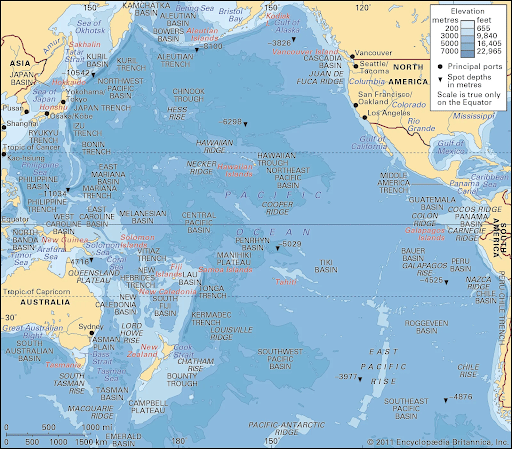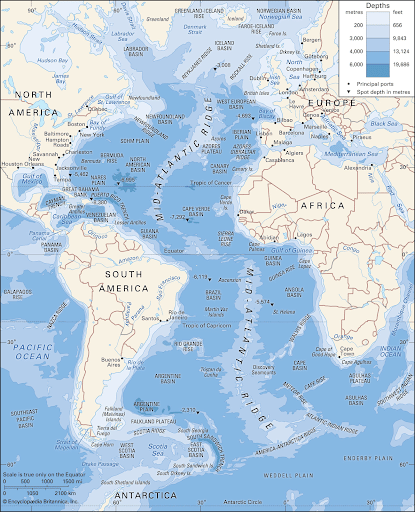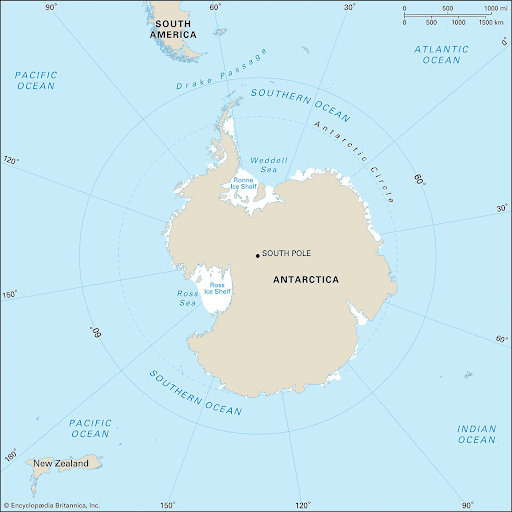Which is the largest Ocean?

If you look out to the horizon from a mirador on the western coast of Colombia, you might start to wonder how big the ocean is, and which one is the largest ocean.
In practice, the ocean is one massive body of water, connected throughout the globe, also known as the Global Ocean.
Ocean waters circulate through the whole planet, regulating the global climate and maintaining the balance of marine ecosystems.
Due to cultural, geographical, and historical factors, human beings have divided the ocean in five recognized ocean basins: the Pacific, Atlantic, Indian, Arctic and Southern Ocean basins.
These bodies of water cover almost 71% of Earth’s surface and contain more than 97% of the planet’s total amount of water.
In this article, we will look at the largest ocean basin on the planet. Find out all its details and then look at all the other ocean basins too!
Let’s start!
Why is the Ocean so important?
Before looking at the largest ocean basin on Earth, let’s try to understand why it is so important for all types of life on the planet.
Here is some information regarding the role of the ocean in our lives. These facts might be surprising, and we hope they will convince you to develop a sustainable relationship with our blue planet.
- The ocean is the largest ecosystem on Earth: it represents the 99% of all the planet’s biosphere.
- The ocean covers about 71% of the Earth’s surface and contains more than 97% of the global water.
- Phytoplankton, a tiny marine alga, produces, through photosynthesis, about 50-80% of the oxygen we breathe.
- The ocean absorbs huge amounts of CO2 (it is a carbon sink), which is of the major causes of climate change.
- Oceans regulate the global climate by moving warm and cold waters around the planet. Warm currents move to the Poles, cool down, and circle back, affecting the Earth’s weather patterns.
- The ocean provides humans with millions of jobs, goods, and services all around the world.
The Largest Ocean basin: The Pacific

Image: Encyclopædia Britannica, Inc.
Yes, the largest ocean basin is, by far, the Pacific Ocean. It stretches from the Western coasts of North and South America to Oceania, Asia and Russia in the North.
Its name comes from the fact that Portuguese explorer Ferdinand Magellan, during his journey to the Philippines, found the Ocean to be quite peaceful, thus “pacific”.
The Pacific Ocean basin has twice the area and more than two times the water volume of the Atlantic, which comes next in terms of size.
One curious fact is that the area of the Pacific exceeds the land of all continents put together.
Occupying almost 30% of the Earth’s surface, the Pacific covers 165,250,000 square kilometers (63,800,000 sq. mi), roughly 46% of the water surface on Earth.
This massive body of water stretches from the Bering Strait, where it is connected to the Arctic Ocean basin, to the 60th parallel South, which marks the Northern limit of the Southern Ocean basin.
The Pacific also connects to the Indian Ocean basin close to the Strait of Malacca, Sumatra, and to the Atlantic by the Strait of Magellan and the Drake Passage. Its greatest latitudinal extent reaches 19,000 km (12,000 miles) between the coast of Colombia and the Malay Peninsula.
The Pacific Ocean basin is also the oldest and deepest of all oceans with an average depth of 4,280 m (14,040 ft). The Challenger Deep in the Mariana Trench, east of the Philippines, is the deepest spot known on Earth, at 11,034 m (36,201 ft) below sea level.
The Mariana Trench is over 2,550 kilometres (1,500 mi) long and 69 kilometres (43 miles) wide. Interesting fact? Mount Everest would fit in the Challenger Deep with over a mile to spare! Another well–known feature of the Pacific is the “Ring of Fire”, where most of the world’s active volcanoes lie underwater.
How large are the other Ocean basins?
There are three recognized major oceans: The Pacific, the Atlantic and the Indian Ocean basins. These are obviously the biggest, in that order. Then, there are the Arctic and Southern Ocean basins, which are smaller.
Let’s learn some more detail about all of them.
The Atlantic Ocean basin

Image: Encyclopædia Britannica, Inc.
The Atlantic Ocean basin separates the continents of Europe and Africa from those of South and North America and it is long and narrow, with an elongated “S” shape. It is usually divided into North and South Atlantic at the Equator.
The Atlantic Ocean basin comes right after the Pacific in terms of size, even if it is remarkably smaller. Still, it covers about one-fifth of Earth’s surface, occupying an area, counting its neighbouring seas, of about 106,400,000 square km (41,100,000 sq. mi), roughly 20% of the planet’s surface, and without these seas, of approximately 81,760,000 square km (31,568,000 sq. mi).
The Atlantic Ocean basin connects to the Pacific through the Arctic Ocean basin in the North and the Drake Passage in the South. A man-made link is the Panama Canal.
Its name, “the sea of Atlas”, comes from Greek mythology.
In terms of depth, it comes after the Pacific with an average of 3,926 meters (12,881 ft) below sea level. Its deepest spot is the Puerto Rico Trench at 8,605 meters (28,232 ft).
Its width varies greatly from North to South: It is roughly 4,830 kilometres (3,000 mi) between North America and Northern Africa, while id decreases to 2,848 kilometres (1,770 mi) between Brazil and Liberia.
The Indian Ocean basin
The Indian is the smallest geologically youngest and most complex of the three major ocean basins. It first appeared about 140 million years ago, but it was not until 36 million years ago that it reached its present configuration.
How large is the Indian Ocean basin?

Image: Encyclopædia Britannica, Inc.
The Indian Ocean basin differs from the Atlantic and Pacific in the fact that, in the Northern Hemisphere, it is landlocked: it does not reach Arctic waters.
It is located between the Eastern coast of Africa and stretches all the way to the island of Tasmania; in the West, it is connected to the Atlantic Ocean basin at Cape Agulhas, in the southern tip of Africa, and its limit continues along the 20° E meridian. In the East, the limits of the Indian Ocean basin are not as clear: they are usually recognized to run from Southeast Cape, in the southern part of Tasmania, along the 147° E meridian, while the northern border is set from Cape Londonderry in Australia, crossing the Timor Sea to the southern shores of Java, and then across the Sunda Strait. Another of its boundaries is often drawn across the Singapore Strait.
In the South, it reaches the recognized northern limits of the Southern Ocean basin, which are located at latitude 60° S.
The Indian Ocean basin is the world’s third-largest ocean with an area of about 70,560,000 square km (27,243,000 square mi). It covers almost 20% of the Earth’s surface. In it, you could fit the USA 5.5 times!
Its widest point is found between Western Australia and the Eastern coast of Africa, measuring almost 1,000 km (6,200 mi).
The Indian Ocean basin’s average depth is 3,741 meters (12,274 feet).
Its deepest spot is found in the Java Trench, also known as the Sunda Trench, at 7,450 meters (24,442 ft), off the southern coast of the island of Java (Indonesia).
The Arctic Ocean basin

Image: Encyclopædia Britannica, Inc.
The Arctic Ocean basin is the smallest of the world 5 oceans, and it is centred approximately on the North Pole.
The ocean is almost completely closed off by the landmasses of North America, Eurasia, and Greenland.
Although the Arctic Ocean basin is by far the smallest of Earth’s oceans, its area is about 14,090,000 square km (5,440,000 sq. mi) which is still five times larger than the Mediterranean, which is the largest sea.
The deepest spot reached in Arctic waters is 5,502 meters (18,050 feet), but its average depth is much lower at 987 meters (3,240 feet).
The Arctic Ocean basin is different from the other basins in many ways: as mentioned above, it is encircled by land, and it has a cover of perennial ice.
Its physical, chemical, and biological processes are therefore quite different from those in the adjacent Atlantic and Pacific Ocean basins. The ice cover, for instance, reduces the exchange of energy between ocean and atmosphere by about 100 times, and it lowers the penetration of sunlight, which is needed for photosynthesis.
Due to its peculiarities, the north polar region has been a subject of speculation for the first concepts of a spherical Earth and the Greeks had even theorized that north of the Arctic Circle there must be a midnight sun at midsummer, and darkness at midwinter.
The Southern Ocean

Image: Encyclopædia Britannica, Inc.
The Southern Ocean basin, also called Antarctic Ocean basin, covers approximately one-sixteenth of the planet’s total ocean area.
The Southern Ocean basin is made up of the parts of the Global Ocean (made up of the Pacific, Atlantic, and Indian ocean basins) and surrounding Antarctica below 60° S.
It is unbroken by any other continental landmass. Its narrowest point is found between South America and the Arctic peninsula, and is known as the Drake Passage, measuring about 1,000 km (600 miles) in width.
The Southern Ocean basin is slightly bigger in size than the Arctic Ocean basin: it covers 21,960,000 square km (8,479,000 square miles), holding 71,800,000 cubic km (17,226,000 cubic miles) of water. Its average depth is of 3,270 meters (10,728 feet) and its maximum depth, in the South Sandwich Trench, southeast of the island of South Georgia, is 7,432 metres (24,383 feet).
On the ocean floor, the continental shelf, in average about 260 km wide (160 miles), attains its maximum width near the Weddell and Ross seas, reaching more than 2,600 km (1,600 miles). There are oceanic basins farther north that are as much as 14,800 feet (4,500 metres) deep, defined by oceanic rises and often marked by ranges of abyssal hills.
Krill is the most important organism in the higher food chain in the Southern Ocean basin, and its waters favour the growth of diatoms and other single-celled plants. On the sea bottom, we find animals like hydrozoans, corals, sponges, bryozoans, sea spiders, isopods, polychaetes, eelpouts, sea snails, rat-tailed fishes, codlike fishes, hagfish, and skates.
References
https://a-z-animals.com/blog/the-largest-ocean-in-the-world/
https://oceaninfo.com/list/largest-oceans-and-seas/
https://www.marinebio.org/oceans/geography/
https://www.wavecity.in/blog/world-ocean-day-5-largest-oceans-in-the-world/


